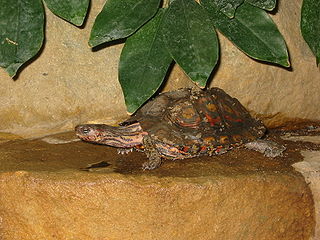
Equidae is the taxonomic family of horses and related animals, including the extant horses, donkeys, and zebras, and many other species known only from fossils. All extant species are in the genus Equus, which originated in North America. Equidae belongs to the order Perissodactyla, which includes the extant tapirs and rhinoceros, and several extinct families.

Nightjars are medium-sized nocturnal or crepuscular birds in the subfamily Caprimulginae and in the family Caprimulgidae, characterised by long wings, short legs and very short bills. They are sometimes called goatsuckers, due to the ancient folk tale that they sucked the milk from goats, or bugeaters, their primary source of food being insects. Some New World species are called nighthawks. The English word "nightjar" originally referred to the European nightjar.

A pseudoscorpion, also known as a false scorpion or book scorpion, is an arachnid belonging to the order Pseudoscorpiones, also known as Pseudoscorpionida or Chelonethida.

Traditionally, the bird order Apodiformes contained three living families: the swifts (Apodidae), the treeswifts (Hemiprocnidae), and the hummingbirds (Trochilidae). In the Sibley-Ahlquist taxonomy, this order is raised to a superorder Apodimorphae in which hummingbirds are separated as a new order, Trochiliformes. With nearly 450 species identified to date, they are the most diverse order of birds after the passerines.

The herons are long-legged, long-necked, freshwater and coastal birds in the family Ardeidae, with 64 recognised species, some of which are referred to as egrets or bitterns rather than herons. Members of the genera Botaurus and Ixobrychus are referred to as bitterns, and, together with the zigzag heron, or zigzag bittern, in the monotypic genus Zebrilus, form a monophyletic group within the Ardeidae. Egrets is not a biologically distinct group from the herons, and tend to be named differently because they are mainly white or have decorative plumes in breeding plumage. Herons, by evolutionary adaptation, have long beaks.

Colubridae is a family of snakes. With 249 genera, it is the largest snake family. The earliest species of the family date back to the Oligocene epoch. Colubrid snakes are found on every continent except Antarctica.

Ovenbirds or furnariids are a large family of small suboscine passerine birds found from Mexico and Central to southern South America. They form the family Furnariidae. The ovenbird, which breeds in North America, is not a furnariid – rather it is a distantly related bird of the wood warbler family, Parulidae.

The Geoemydidae are one of the largest and most diverse families in the order Testudines (turtles), with about 70 species. The family includes the Eurasian pond and river turtles and Neotropical wood turtles.

Emydidae is a family of testudines (turtles) that includes close to 50 species in 10 genera. Members of this family are commonly called terrapins, pond turtles, or marsh turtles. Several species of Asian box turtles were formerly classified in the family; however, revised taxonomy has separated them to a different family (Geoemydidae). As currently defined, the Emydidae are entirely a Western Hemisphere family, with the exception of two species of pond turtle.

The Pterophoridae or plume moths are a family of Lepidoptera with unusually modified wings. Though they belong to the Apoditrysia like the larger moths and the butterflies, unlike these they are tiny and were formerly included among the assemblage called "microlepidoptera".
The Syndiniales are an order of early branching dinoflagellates, found as parasites of crustaceans, fish, algae, cnidarians, and protists. The trophic form is often multinucleate, and ultimately divides to form motile spores, which have two flagella in typical dinoflagellate arrangement. They lack a theca and chloroplasts, and unlike all other orders, the nucleus is never a dinokaryon. A well-studied example is Amoebophrya, which is a parasite of other dinoflagellates and may play a part in ending red tides. Several MALV groups have been assigned to Syndiniales; recent studies, however, show paraphyly of MALVs suggesting that only those groups that branch as sister to dinokaryotes belong to Syndiniales.

Kinosternoidea is a superfamily of aquatic turtles, which includes two families: Dermatemydidae, and Kinosternidae.

Trionychia is a superfamily of turtles which encompasses the species that are commonly referred to as softshelled turtles as well as some others. They are found throughout the temperate regions of the world. The Jurassic genus Sinaspideretes is considered the earliest representative of the superfamily.

Cyclanorbis is a genus of softshell turtles in the family Trionychidae. The genus is endemic to Africa.

Cycloderma is a genus of softshell turtles in the subfamily Cyclanorbinae of the family Trionychidae. The genus is endemic to Africa.
Bleasdalea is a genus of flowering plants in the family Proteaceae.

In biological classification, taxonomic rank is the relative level of a group of organisms in a taxonomic hierarchy. Examples of taxonomic ranks are species, genus, family, order, class, phylum, kingdom, domain, etc.

The Hymenogastraceae are a family of fungi in the order Agaricales with both agaric and false-truffle shaped fruitbodies. Formerly, prior to molecular analyses, the family was restricted to the false-truffle genera. The mushroom genus Psilocybe in the Hymenogastraceae is now restricted to the hallucinogenic species while nonhallucinogenic former species are largely in the genus Deconica classified in the Strophariaceae.

Helotidae is a family of beetles, in the suborder Polyphaga. The family includes about five extant genera, Helota MacLeay, Neohelota Ohta, Afrohelotina Kirejtshuk, Metahelotella Kirejtshuk, and Strophohelota Kirejtshuk. Helotidae are found mainly in the Old World tropics and are absent from Australia and Madagascar. The antennae are clubbed on the final three segments and is retractable within grooves under the head. The wings have reduced venation with just 4 anal veins.
Eucarpha is a genus of flowering plant of the family Proteaceae, endemic to New Caledonia. Two species are recognised. Up until 1975, these were classified within the genus Knightia until Lawrie Johnson and Barbara G. Briggs recognised their distinctness, particularly their prominent bracts, in their 1975 monograph "On the Proteaceae: the evolution and classification of a southern family". As of today, the nomenclatural combinations for these two species in the genus Eucarpha have not been published.

















